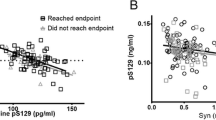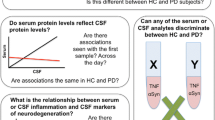Abstract
Leucine-rich repeat kinase 2 (LRRK2) gene mutations are the most common genetic cause of Parkinson’s disease (PD). CSF specimens from LRRK2 + PD patients and healthy LRRK2 mutation carriers are, therefore, useful for biomarker studies. This study examined the hypothesis that differences are present between subjects with sporadic PD (sPD), PD carriers of LRRK2 mutations (LRRK2 + PD), healthy control subjects lacking LRRK2 mutations (CTL), and LRRK2 mutation-carrying healthy controls (LRRK2 + CTL) for CSF concentrations of six potential PD biomarkers. Two of these proteins, nuclear factor (erythroid-derived 2)-like 2 (“Nrf2”) and heat shock 70 kDa protein 8 (“HSPA8”), were detected in preliminary ELISAs, then measured in a larger cohort (60 sPD, 10 LRRK2 + PD, 23 CTL, 31 LRRK2 + CTL). No statistically significant differences were found between the groups (Nrf2 p = 0.13, HSPA8 p = 0.21). Nrf2 concentrations in LRRK2 + PD subjects were strongly positively associated with Unified Parkinson’s Disease Rating Scale (UPDRS) total and motor scores [Spearman rho = 0.77 (p = 0.012) and 0.83 (p = 0.005)] and negatively associated with Montreal Cognitive Assessment (MoCA) scores (rho = −0.57; p = 0.11). Partial correlation coefficient calculations indicated that disease duration contributed to the associations of Nrf2 levels with UPDRS scores and with MoCA scores in this group. While CSF Nrf2 and HSPA8 do not appear to offer diagnostic biomarkers for PD, the associations between Nrf2 levels and UPDRS scores in LRRK2 + PD patients merit further investigation.




Similar content being viewed by others
References
Aasly JO, Vilarino-Guell C, Dächsel JC, Webber PJ, West AB, Haugarvoll K et al (2010) Novel pathogenic LRRK2 p.Asn1437His substitution in familial Parkinson’s disease. Mov Disord 25:2156–2163
Aasly JO, Shi M, Sossi V, Stewart T, Johansen KK, Wszolek ZK et al (2012) Cerebrospinal fluid amyloid β and tau in LRRK2 mutation carriers. Neurology 78:55–61
Aasly JO, Johansen KK, Brønstad G, Warø BJ, Majbour NK, Varghese S et al (2014) Elevated levels of cerebrospinal fluid α-synuclein oligomers in healthy asymptomatic LRRK2 mutation carriers. Front Aging Neurosci 6:248
Alvarez-Erviti L, Rodriguez-Oroz MC, Cooper JM, Caballero C, Ferrer I, Obeso JA et al (2010) Chaperone-mediated autophagy markers in Parkinson disease brains. Arch Neurol 67:1464–1472
Bayir H, Kagan VE, Tyurina YY, Tyurin V, Ruppel RA, Adelson PD et al (2002) Assessment of antioxidant reserves and oxidative stress in cerebrospinal fluid after severe traumatic brain injury in infants and children. Pediatr Res 51:571–578
Blesa J, Trigo-Damas I, Quiroga-Varela A, Jackson-Lewis VR (2015) Oxidative stress and Parkinson’s disease. Front Neuroanat 9:91
Dang J, Brandenburg LO, Rosen C, Fragoulis A, Kipp M, Pufe T et al (2012) Nrf2 expression by neurons, astroglia, and microglia in the cerebral cortical penumbra of ischemic rats. J Mol Neurosci 46:578–584
D’Angelo B, Ek CJ, Sandberg M, Mallard C (2013) Expression of the Nrf2-system at the blood-CSF barrier is modulated by neonatal inflammation and hypoxia-ischemia. J Inherit Metab Dis 36:479–490
Dice JF (2007) Chaperone-mediated autophagy. Autophagy 3:295–299
Di Fonzo A, Rohé CF, Ferreira J, Chien HF, Vacca L, Stocchi F et al (2005) A frequent LRRK2 gene mutation associated with autosomal dominant Parkinson’s disease. Lancet 365:412–415
Djaldetti R, Lev N, Melamed E (2009) Lesions outside the CNS in Parkinson’s disease. Mov Disord 24:793–800
Gelb DJ, Oliver E, Gilman S (1999) Diagnostic criteria for Parkinson disease. Arch Neurol 56:33–39
Gilks WP, Abou-Sleiman PM, Gandhi S, Jain S, Singleton A, Lees AJ et al (2005) A common LRRK2 mutation in idiopathic Parkinson’s disease. Lancet 365:415–416
Grünblatt E, Mandel S, Jacob-Hirsch J, Zeligson S, Amariglo N, Rechavi G et al (2004) Gene expression profiling of parkinsonian substantia nigra pars compacta; alterations in ubiquitin-proteasome, heat shock protein, iron and oxidative stress regulated proteins, cell adhesion/cellular matrix and vesicle trafficking genes. J Neural Transm 111:1543–1573
Grünblatt E, Zehetmayer S, Jacob CP, Müller T, Jost WH, Riederer P (2010) Pilot study: peripheral biomarkers for diagnosing sporadic Parkinson’s disease. J Neural Transm 117:1387–1393
Itoh K, Chiba T, Takahashi S, Ishii T, Igarashi K, Katoh Y et al (1997) An Nrf2/small Maf heterodimer mediates the induction of phase II detoxifying enzyme genes through antioxidant response elements. Biochem Biophys Res Commun 236:313–322
Jain AK, Bloom DA, Jaiswal AK (2005) Nuclear import and export signals in control of Nrf2. J Biol Chem 280:29158–29168
Johansen KK, Wang L, Aasly JO, White LR, Matson WR, Henchcliffe C et al (2009) Metabolomic profiling in LRRK2-related Parkinson’s disease. PLoS ONE 4:e7551
Kachergus J, Mata IF, Hulihan M, Taylor JP, Lincoln S, Aasly J et al (2005) Identification of a novel LRRK2 mutation linked to autosomal dominant parkinsonism: evidence of a common founder across European populations. Am J Hum Genet 76:672–680
Kiffin R, Christian C, Knecht E, Cuervo AM (2004) Activation of chaperone-mediated autophagy during oxidative stress. Mol Biol Cell 15:4829–4840
Kumar H, Lim HW, More SV, Kim BW, Koppula S, Kim IS et al (2012) The role of free radicals in the aging brain and Parkinson’s disease: convergence and parallelism. Int J Mol Sci 13:10478–10504
LeWitt PA, Huber BR, Zhang J (2013) An update on CSF biomarkers of Parkinson’s disease. In: Mandel S (ed) Neurodegenerative diseases: integrative PPPM approach as the medicine of the future, advances in predictive, preventive, and personalized medicine, vol 2. Springer, Dordrecht, pp 161–184
Liu T, Daniels CK, Cao S (2012) Comprehensive review on the HSC70 functions, interactions with related molecules and involvement in clinical diseases and therapeutic potential. Pharmacol Ther 136:354–374
Mandel S, Grunblatt E, Riederer P, Amariglio N, Jacob-Hirsch J, Rechavi G et al (2005) Gene expression profiling of sporadic Parkinson’s disease substantia nigra pars compacta reveals impairment of ubiquitin-proteasome subunits, SKP1A, aldehyde dehydrogenase, and chaperone HSC-70. Ann NY Acad Sci 1053:356–375
Martin I, Kim JW, Dawson VL, Dawson TM (2014) LRRK2 pathobiology in Parkinson’s disease. J Neurochem 131:554–565
Molochnikov L, Rabey JM, Dobronevsky E, Bonucelli U, Ceravolo R, Frosini D et al (2012) A molecular signature in blood identifies early Parkinson’s disease. Mol Neurodegener 7:26
Nakamura K, Wang W, Kang UJ (1997) The role of glutathione in dopaminergic neuronal survival. J Neurochem 69:1850–1858
Nandhagopal R, Mak E, Schulzer M, McKenzie J, McCormick S, Sossi V et al (2008) Progression of dopaminergic dysfunction in a LRRK2 kindred: a multitracer PET study. Neurology 71:1790–1795
Rajput AH, Rajput A (2014) Accuracy of Parkinson disease diagnosis unchanged in 2 decades. Neurology 83:386–387
Ramsey CP, Glass CA, Montgomery MB, Lindl KA, Ritson GP, Chia LA et al (2007) Expression of Nrf2 in neurodegenerative diseases. J Neuropathol Exp Neurol 66:75–85
Redeker V, Pemberton S, Bienvenut W, Bousset L, Melki R (2012) Identification of protein interfaces between α-synuclein, the principal component of Lewy bodies in Parkinson disease, and the molecular chaperones human Hsc70 and the yeast Ssa1p. J Biol Chem 287:32630–32639
Sala G, Arosio A, Stefanoni G, Melchionda L, Riva C, Marinig D et al (2013) Rotenone upregulates alpha-synuclein and myocyte enhancer factor 2D independently from lysosomal degradation inhibition. Biomed Res Int 2013:846725
Schrag A, Schott JM (2006) Epidemiological, clinical, and genetic characteristics of early-onset parkinsonism. Lancet Neurol 5:355–363
Shi M, Bradner J, Hancock AM, Chung KA, Quinn JF, Peskind ER et al (2011) Cerebrospinal fluid biomarkers for Parkinson disease diagnosis and progression. Ann Neurol 69:570–580
Shults CW, Haas RH, Passov D, Beal MF (1997) Coenzyme Q10 levels correlate with the activities of complexes I and II/III in mitochondria from parkinsonian and nonparkinsonian subjects. Ann Neurol 42:261–264
Suh JH, Shenvi SV, Dixon BM, Liu H, Jaiswal AK, Liu RM et al (2004) Decline in transcriptional activity of Nrf2 causes age-related loss of glutathione synthesis, which is reversible with lipoic acid. Proc Natl Acad Sci USA 101:3381–3386
Trachootham D, Lu W, Ogasawara MA, Nilsa RD, Huang P (2008) Redox regulation of cell survival. Antioxid Redox Signal 10:1343–1374
Uitti RJ, Calne DB (1993) Pathogenesis of idiopathic parkinsonism. Eur Neurol 33(Suppl 1):6–23
Acknowledgments
This study was supported by Beaumont Health System’s Neuroscience Center of Excellence and by donations from Ms. Marilyn Bishop and the family of Mr. Norman Merollis, which are gratefully acknowledged.
Author information
Authors and Affiliations
Corresponding author
Rights and permissions
About this article
Cite this article
Loeffler, D.A., Smith, L.M., Coffey, M.P. et al. CSF Nrf2 and HSPA8 in Parkinson’s disease patients with and without LRRK2 gene mutations. J Neural Transm 123, 179–187 (2016). https://doi.org/10.1007/s00702-015-1479-0
Received:
Accepted:
Published:
Issue Date:
DOI: https://doi.org/10.1007/s00702-015-1479-0




